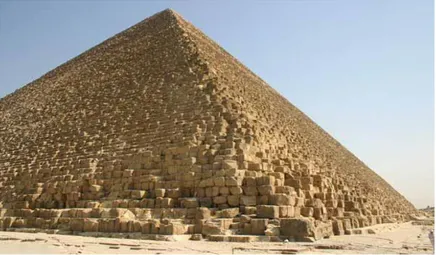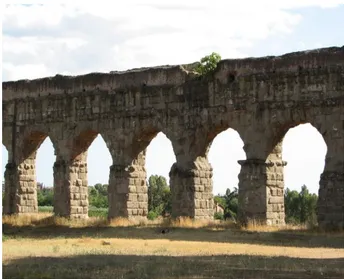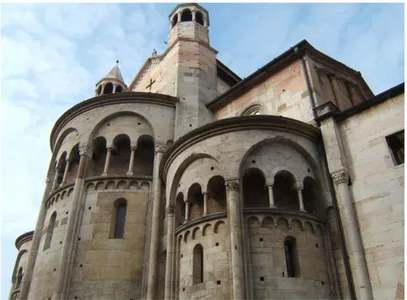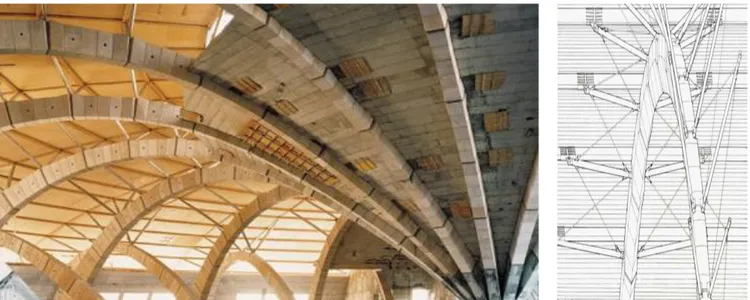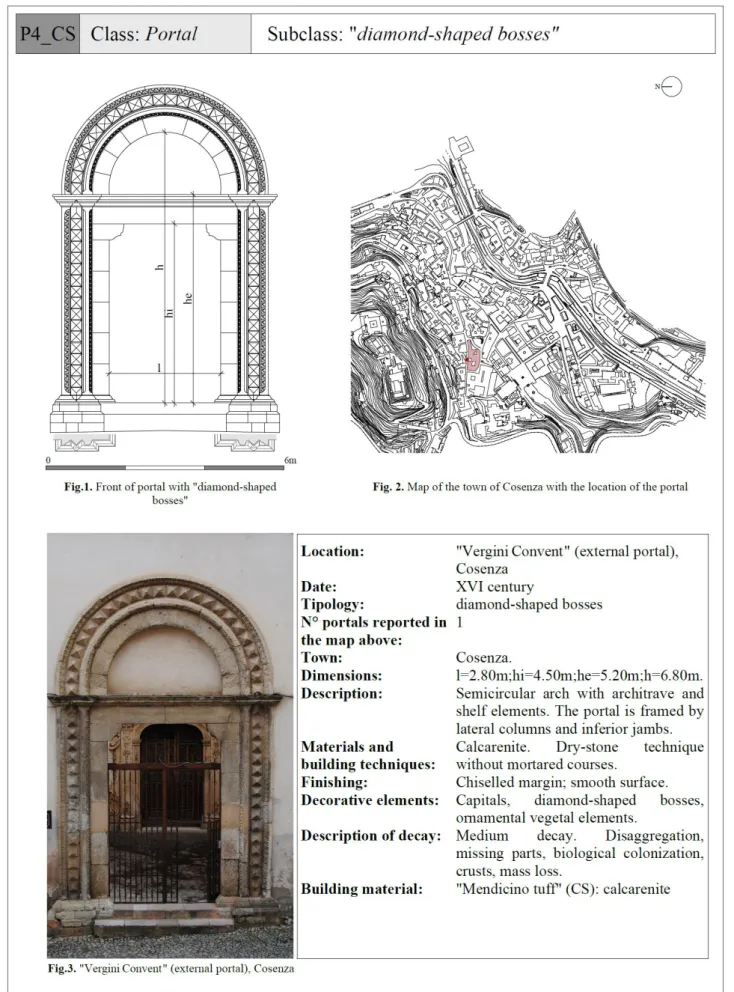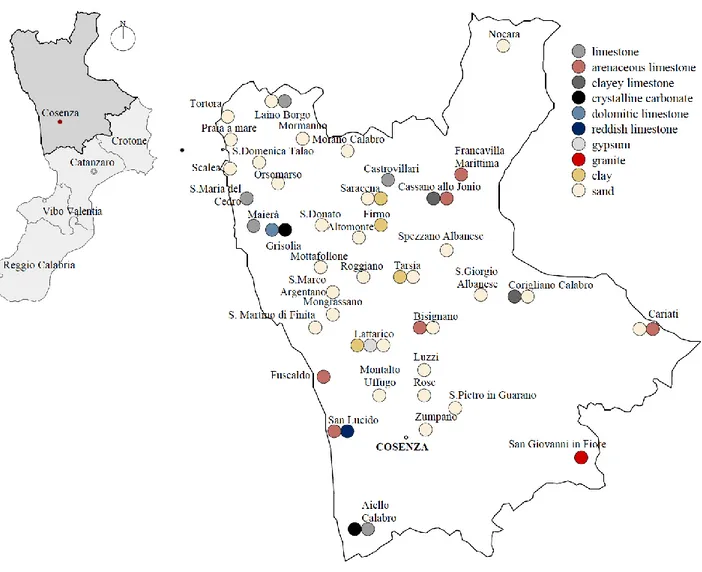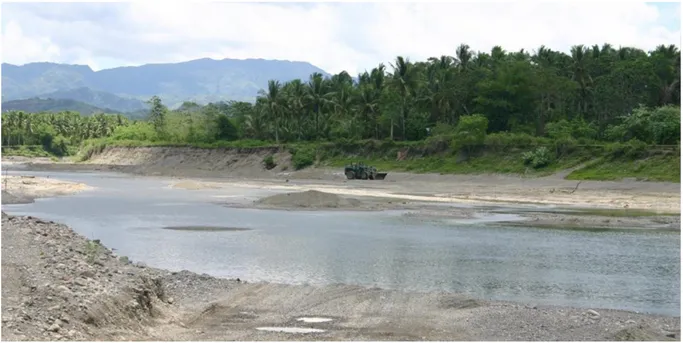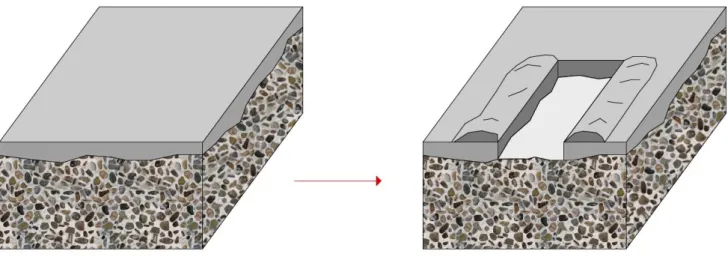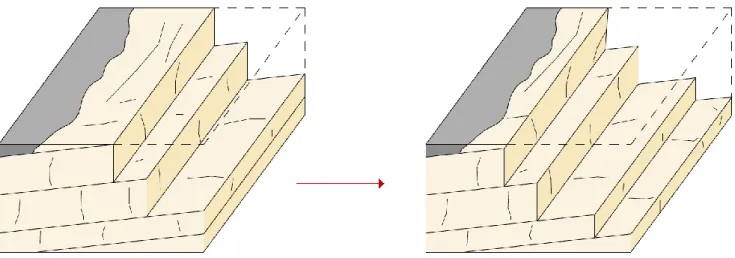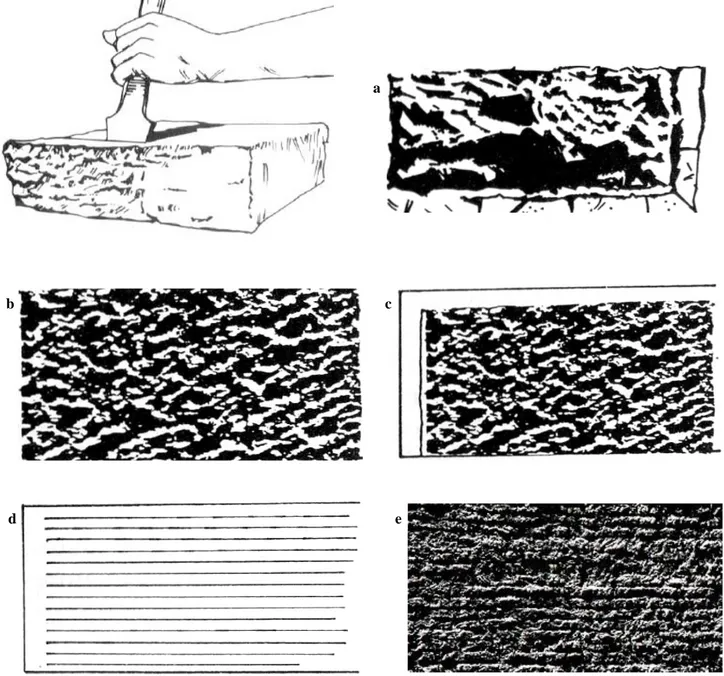II
Index
Index ... II Acknowledgements ... VII Abstract ... IX Executive summary ... XII Sintesi ... XVII Articolazione e contenuti ... XXI Abbreviations ... XXVI
1. Objectives ... 2
2. Introduction – Building stones in architecture ... 5
2.1 Natural stone uses in Architecture ... 7
2.2 Stone deterioration ... 13
3. Stones selection ... 18
3.1 Criteria for the selection ... 18
3.2 Historical background and architectural models ... 18
3.2.1 The school of stonemasons of San Giovanni in Fiore ... 19
3.2.2 The school of stonemasons of Basilicata and the northern part of Calabria ... 26
3.2.3 The schools of stonemasons of Rogliano and Altilia ... 29
3.2.4 The school of stonemasons of Fuscaldo ... 36
3.3 Quarries and materials – Calabria and Cosenza Province ... 44
3.3.1 Natural stones ... 44
3.3.2 Italian and Calabrian stone market ... 46
3.3.3 Ancient quarries of Cosenza Province ... 53
3.3.4 Italian and Calabrian quarry standards... 58
3.3.5 Types of quarries of Cosenza Province ... 60
3.3.6 Extraction methods of Cosenza Province ... 63
3.3.7 Traditional types of stone finishing of Cosenza Province ... 68
Rock faced ... 69
Rough pointed with/without chiseled margin ... 69
Furrowed surface ... 69
Bush-hammered ... 69
3.4 Selected stones – Architectural and geological setting ... 70
3.4.1 San Giovanni in Fiore granite ... 70
III
3.4.2 Grisolia stone ... 77
Geological setting and stone extraction ... 79
3.4.3 San Lucido calcarenite ... 81
Geological setting and stone extraction ... 83
3.4.4 Fuscaldo sandstone ... 88
Geological setting and stone extraction ... 89
4. Cosenza Province masonries: construction techniques ... 92
4.1 Uncoursed random rubble masonry ... 93
4.2 Coursed random rubble ... 101
4.3 Ashlar masonry ... 103
5. Methods and materials ... 106
5.1 Sampling and sample preparation ... 106
5.2 Techniques applied for the material characterization (NDT and laboratory tests) and rock fabrics (anisotropy)... 109
5.3 Petrographic description ... 110
5.4 Chemical and mineralogical characterization ... 111
5.5 Surface properties ... 113
5.5.1 Chromatic parameters ... 114
5.6 Petrophysical properties ... 118
Porosity... 118
5.6.1 Porosity accessible to water and real and bulk densities ... 119
5.6.2 Mercury intrusion porosimetry (MIP) ... 121
5.6.3 Air permeability ... 123
5.7 Hydric properties ... 124
5.7.1 Capillary water absorption – (Infrared Camera) ... 125
5.7.2 Water absorption/desorption at atmospheric pressure ... 126
Water absorption ... 126
Water desorption ... 128
5.7.3 Natural hydrophobicity by water static contact angle ... 129
5.8 Mechanical properties... 130
Anisotropy ... 130
5.8.1 Ultrasound propagation velocity (P waves) ... 132
5.8.2 Ultrasound propagation velocity (S waves) ... 134
Hardness ... 136
5.8.3 Micro-hardness (Equotip), drilling resistance measuring system (DRMS) and Schmidt Hammer
IV
Micro-hardness ... 137
Drilling resistance ... 138
Schmidt hammer test ... 140
Strength properties ... 142
5.8.4 Uniaxial compressive strength ... 142
5.8.5 Flexural strength ... 144
5.8.6 Indirect Tensile strength test (Brazilian test) ... 146
5.8.7 Point Load test ... 148
Abrasion Resistance ... 149
5.8.8 Polished Stone Value ... 150
Los Angeles ... 150
Micro-Deval ... 152
6. Characterization: results ... 156
6.1 Petrographic description ... 156
San Giovanni in Fiore granite (GF) ... 156
Grisolia stone (DG) ... 165
San Lucido calcarenite (CS) ... 168
Fuscaldo sandstone (AF) ... 171
6.2 Chemical and mineralogical characterization ... 174
6.3 Surface properties ... 175
6.3.1 Chromatic parameters ... 175
6.4 Petrophysical properties ... 179
6.4.1 Porosity accessible to water and real and bulk densities ... 180
6.4.2 Mercury intrusion porosimetry (MIP) ... 181
6.4.3 Air permeability ... 184
6.5 Hydric properties ... 186
6.5.1 Capillary water absorption – (Infrared Camera) ... 186
6.5.2 Water absorption/desorption at atmospheric pressure ... 196
Water absorption ... 196
Water desorption ... 202
6.5.3 Natural hydrophobicity by water static contact angle ... 206
6.6 Mechanical properties... 207
6.6.1 Ultrasound propagation velocity (P waves) ... 207
6.6.2 Ultrasound propagation velocity (S waves) ... 209
6.6.3 Leeb Micro-hardness (Equotip), Drilling resistance and Schmidt hammer test ... 211
V
6.6.5 Flexural strength ... 230
6.6.6 Indirect Tensile strength test (Brazilian test) ... 235
6.6.7 Point Load test ... 239
6.6.8 Polished Stone Value ... 240
Los Angeles and Micro-Deval ... 240
7. Discussion and summary of stone properties ... 244
Mineralogical, chemical and petrographic correlation ... 244
Pore system and correlation between porosity and mechanical properties ... 247
Hydric behavior ... 265
Correlation between ultrasonic velocities, petrographic properties and stiffness ... 267
Correlation between Drilling resistance and mechanical properties ... 272
Correlation between compressive, tensile and flexural strengths ... 276
Correlation between Point Load and mechanical properties ... 283
8. Durability ... 288
8.1 Action of salts ... 288
8.2 Salt crystallization process ... 289
8.3 Salt crystallization test ... 290
8.3.1 Procedure ... 290
8.3.2 Results of the salt crystallization test... 291
8.3.3 Discussion of the salt crystallization test... 297
8.4 Ice crystallization process ... 304
8.5 Freeze-thaw test ... 306
8.5.1 Procedure ... 306
8.5.2 Results of the freeze-thaw test ... 307
Visual changes ... 307
Weight loss ... 308
Ultrasound velocity ... 308
Mechanical properties ... 310
8.5.3 Discussion of results of freeze-thaw test ... 312
9. Limitations of the study and techniques used ... 316
Surface properties ... 316
Hydric properties ... 317
Hardness properties ... 318
Ultrasound propagation velocity ... 318
Mechanical properties ... 319
VI
10.1 Use suggestions ... 324
10.1.1 Water absorption and porosity ... 325
10.1.2 Uniaxial compressive strength ... 325
A) Slabs ... 325 B) Masonry ... 327 10.1.3 Flexural strength ... 330 10.1.4 Micro-hardness ... 332 10.1.5 Frosting ... 333 10.2 Conclusions ... 335
San Giovanni in Fiore granite (GF) ... 336
Grisolia stone (DG) ... 339
San Lucido calcarenite (CS) ... 342
Fuscaldo sandstone (AF) ... 344
General conclusions ... 347
Symbols used ... 350
Bibliography ... 352
VII
Acknowledgements
The research was carried out in Italy and Spain. In Italy: at the Department of Civil Engineering of the University of Calabria, where Peppino Sposato, Pasquale Pedace and Tonino Carrozzino helped me very much with the mechanical tests; at the Department of Territory and Environment of the University of Calabria, where Fortunato Crea and Ivan Iacobini were helpful with the portable mechanical tests; at the Department of Biology, Ecology and Earth Sciences of the University of Calabria, where Mauro and Silvio worked with me for the durability tests; at the IPG Laboratory “Istituto Prove Geotecniche” of Castrolibero with Sergio Soleri and his colleagues to perform mechanical tests on aggregates. In Spain, in Madrid, at the Petrophysics Laboratory IGEO (CSIC-UCM), “Centro Mixto del Consejo Superior de Investigaciones Científicas (CSIC) y de la Universidad Complutense de Madrid (UCM)”, where I performed the petrophysical, chemical and mineralogical characterization of the analyzed samples, thanks to the supports of “Programa de Geomateriales 2 (S2013/MIT-2914)” and to the Fellowship “Fondi 5 per mille D.P.C.M. 23/04/2010”. I received a lot of professional help from the researchers of the Applied Petrology for Heritage Conservation Research Group, especially form my tutor Mónica Alavarez de Buergo and from Rafael Fort that taught me professionally and humanly new scientific aspects. I am very grateful for it. David, Natalia, Du, Inma, Andrés, Elena, Mari Carmen, Arancha, Miguel, Luz, Maria José, Blanca, Patricia, all my fellow workers from the same group also deserve my gratitude. Without IGEO Group I would have never learnt and achieved the half of what I did. Thank you all. I am very grateful to them to welcome me so warmly and to be willing to co-operate any time. From the same department I have to express my thanks to the technical staff for the several thin sections and samples they prepared for me.
Quiero dar las gracias a todas las personas en Madrid que me ayudaron a adaptarme a esta cultura y sociedad científica tan maravillosa. Me han transmitido mucho, a nivel profesional y sobre
VIII todo a nivel personal. La estancia en Madrid ha sido una de las etapas más importantes de este trabajo y que me ha cambiado la vida. A parte las personas que ya están mencionadas quiero dar mis gracias a Conchita por su cariño y a muchos más.
Vorrei inoltre ringraziare i miei tutor e co-tutors per avermi supportata ed aiutata durante questi tre anni. I professori Maurizio Ponte, Alessandro Campolongo, Anna Maria De Francesco dell’Università della Calabria e nuovamente Mónica Alvarez De Buergo dell’IGEO, per avermi trasmesso le basi scientifiche e l’appoggio morale per portare avanti questo progetto di dottorato.
Un ringraziamento speciale e di cuore va alle persone che ci sono sempre state al mio fianco: i miei genitori, che da sempre con il loro amore mi hanno supportata ed hanno creduto in me e nelle mie capacità sin dal principio, appoggiando le mie scelte standomi sempre vicina; la famiglia, i miei amici, Simona, per aver vissuto da lontano le esperienze di questi tre anni ma sempre con la vicinanza incredibile che contraddistingue la nostra amicizia, Veronica e Concetta per avermi ascoltata anche nei momenti più difficili e per aver condiviso e riso con me delle diverse avventure di questo periodo; a tutte quelle persone “nuove” che sono arrivate grazie a questa esperienza; Carlos (por supuesto) per l’amore immenso che mi ha regalato cambiando totalmente la mia vita con la sua energia, travolgendomi e facendomi innamorare di un nuovo mondo meraviglioso che ignoravo potesse esistere; la sua famiglia ed i suoi amici che sono entrati nella mia vita e che mi hanno accolta come “una di loro” sin dal primo istante; Nilla e Neil per l’aiuto ed i preziosi consigli che mi hanno regalato, come solo i veri amici sanno fare. Grazie davvero per tutto ciò che mi avete dato durante questi meravigliosi anni.
Thank you all! ¡Gracias a todos! Grazie a tutti voi!
IX
Abstract
The aim of this PhD thesis is to provide new scientific data regarding the use of certain Calabrian stones as building materials. This investigation included specific local stones used by the most important schools of Stonemasons of Calabria, in particular in the Cosenza Province; focusing on how properties of different building materials have influenced the figurative and architectural models.
In this study, stones commonly used as building materials are selected according to two important criteria:
1. The large employment of these materials in the past as building and decorative elements. Studying the use of selected stones in the centuries assists in identifying four lithotypes largely used by the most important Calabrian Schools of Stonemasons in the Cosenza Province:
• San Giovanni in Fiore granite - in the Sila area by the school of San Giovanni in Fiore and famous for its severe style due to “Joachim of Fiore” rules, and to material hardness.
• Grisolia stone – known as “gold stone” for its gold inclusions; limestone that represents the principal building material of the majority of the historical centers of the northern Tyrrhenian part of the Calabrian region and a small part of the Basilicata region.
• San Lucido stone - biocalcarenite known in the past as “biancolella”; employed as a building material in the historical center of San Lucido and in the historical center of Cosenza, to build structural and decorative elements such as portals and arches.
• Fuscaldo stone - sandstone commercially known as “sweet stone” and utilized by artisans of the 14th century school of Fuscaldo; principally known for the construction of portals of noble palaces, built in the Spanish “plateresco” (plateresque) style for ornamental elements.
X 2. Lithotypes belonging to the different active and non-active important quarry areas of the Cosenza Province. Also taken into account is the possibility that these quarries may still be exploited for a local limited use, or a possible diffusion on a large scale out of the Region.
Special attention is dedicated to the characterization, durability, and to the building techniques employed in the past of the selected stones.
The petrophysical and mechanical characterization of these stones are performed by means of studying the petrographic characteristics, chemical and mineralogical composition, hydric properties; and the physical and mechanical behavior, with special attention to possible anisotropies. For this purpose, laboratory and non-destructive tests on quarry samples complying the current standards for “natural stones” and for the “conservation of cultural property” are performed.
Salt crystallization and freeze-thaw tests are performed to assess the durability of the stones and to relate the investigated stone properties with their behavior towards decay agents.
Among all the investigated lithotypes, San Giovanni in Fiore granite and Grisolia stone result the stones with a better mechanical and resistance behavior than the other lithotypes. In terms of durability, they are the most durable stones, and in terms of mechanical strength resistance, the strongest stones, both suitable for indoor and outdoor uses. But, petrographically, in the case of San Giovanni in Fiore granite, the oriented sets of microcracks demonstrate that microcracks influence the physical and mechanical behavior of this lithotype. In fact, comparing San Giovanni in Fiore granite with other similar granites, this stone presents worse properties and an anisotropic strength behavior, connected to the different orientation of its intracrystalline and intercrystalline microcracks. San Lucido calcarenite is classified as a stone with better mechanical features than petrophysical and hydric properties, so, the recommended use is for structural purposes, especially inside rather than for ornamental and external uses, in general where salts are not present. Concerning both petrohysical-mechanical properties and
XI durability, Fuscaldo sandstone is the stone with the worst behavior, if compared with the other investigated lithotypes. Its mineralogical composition connected to the susceptibility of some minerals, its high open porosity, the presence of a lot of micropores, its anisotropic hydric behavior, the high degree of ultrasonic anisotropy and its low mechanical strengths, makes this stone sensitive to decay processes and the recommendation is to use this stone for inside purposes and where no salts are present.
Results demonstrate that anisotropy and porosity are the main influencing factor in the stone behavior and durability. The way in which stones are positioned can avoid decay processes and improve their petrophysical-mechanical properties. In particular, it is suggested positioning the most anisotropic lithotypes (e.g. Fuscaldo sandstone) with the Z-direction parallel to the loading direction to obtain higher strengths and, simultaneously, to minimize water absorption. Moreover the pore structure, the pore-size distribution, the open porosity and the hydric behavior influence directly the stone resistance in front of decay agents. Microporous stones (e.g. Fuscaldo sandstone) or stones with high capillary coefficients (e.g. San Lucido calcarenite) have been classified as more susceptible to decay agents.
Furthermore, an attempt is made to consider possible modifications of current standards and performed non-destructive techniques, strictly focusing on the applied methods and the tested material of this research. In conclusion, all obtained results indicate the optimum use and the best methodology to perform, for the four investigated stones as building materials with regards to the stones’ properties and with particular attention to different behaviors towards the anisotropy.
Keywords: characterization; destructive and non-destructive tests; durability; cultural heritage; new constructions; engineering geology; use suggestions.
XII
Executive summary
The thesis “Some Calabrian stones as building materials: characterization, durability and use suggestions”, is divided into 10 chapters.
(1) Chapter 1 – presents the main objectives of this thesis:
I. Objective 1 - establishes the history of use, quality, and quarriability of four building stones from the Cosenza Province, which are widely used in the vernacular architecture and monumental buildings.
II. Objective 2 - characterizes the four selected stones by means of laboratory and non-destructive tests to obtain a complete petrophysical, chemical, mineralogical, and mechanical characterization; highlighting the most influential factors on the resistance for each lithotype, with a special attention to the anisotropy.
III. Objective 3 - defines the durability of the four lithotypes.
IV. Objective 4 - obtains the most adequate methodology for the characterization.
V. Objective 5 - defines recommendations and suggests uses for the studied stones as building materials according to the properties obtained through characterization and durability tests.
(2) Chapter 2 – Presents an overview of the building stones’ usage throughout the centuries. Since the prehistoric age, stones have been used for their unique durability to erect monuments of extraordinary and mostly religious importance. Until the 19th century, principally local stones were used from nearby sources, due to the lack of transportation facilities. Only rare and ornamental stones, such as marble, were transported from long distances and employed in exceptional cases. In all building types, the common factor was the adaptability of the building structure to the mineralogical, physical, and mechanical properties of stone. Medieval builders that succeeded in the erection of high and light structures such as Gothic church choirs or spires, could only stabilized the
XIII construction with the help of hidden steel anchors. In fact, the high compressive strength and the low tensile strength of stone required special techniques to overarch gateways and to erect vaults. Only with the use of steel and reinforced concrete, the limits that stone properties posed to building structures had been overcome, and a new era of architectural building design began.
A precise description of all alteration types is presented; a definition of the distinction among the terms of “decay”, “deterioration”, “degradation”, “alteration”, “weathering”, and “damage”; and the most influencing ageing factors affecting stone durability.
(3) Chapter 3 – Considers and illustrates the principal criteria in selecting the four lithotypes: Historical importance and the role of building stones in the Cosenza Province; most important Schools of Stonemasons working in the study area and their architectural models; role of the quarry activity in the past and the actual number of active quarries; and the stones’ quarriability for a possible diffusion out of the Province, both for architectural and engineering purposes.
The selected stones are: San Giovanni in Fiore granite (GF); Grisolia stone (DG); Fuscaldo sandstone (AF); and San Lucido calcarenite (CS).
A thorough literature review is conducted on the exploitation and use of these stones, which form part of many monuments, buildings, engineering elements, streets, and almost all vernacular architectures of the Cosenza Province. These include ancient building and modern engineering or civil structures (streets, milestones, portals, vaults, bridges).
I. GF – grey granite named “Sila granite” belonging to the Sila Batholith, was principally employed by the School of Stonemasons of San Giovanni in Fiore, for ordinary masonries and engineering purposes.
II. DG – “gold stone”, named for its yellow veins; a grey crystalline carbonate, geologically belonging to the Verbicaro Unit was exploited by the tradition of the School of Stonemasons of
XIV Basilicata and the northern part of Calabria, to realize common buildings and noble portals of the Pollino Area, Tyrrhenian coast, and of old towns out of Region.
III. AF – reddish sandstone known as “sweet stone” due to its easy workability; belonging to the Miocenic Succession of the Tyrrhenian Coast, was principally employed by the School of Stonemasons of Fuscaldo.
IV. CS – whitish biocalcarenite commercially known as “Mendicino tuff”; used by the School of Stonemasons of Rogliano and Altilia, belonging to the Miocenic Successions of the Tyrrhenian Coast, was principally employed for vernacular and monumental architectures of Cosenza Province.
(4) Chapter 4 – Illustrates the usage of the selected four stones in the past, the principal constructive techniques adopted by Stonemasons, and considers important realized examples, such as the masonries of four old towns (San Giovanni in Fiore, Scalea, Fuscaldo, San Lucido).
(5) Chapter 5 – Describes methods, methodologies, and followed adopted standards to perform the characterization of the four lithotypes. Non-destructive (NDT), micro-destructive (MDT), and destructive techniques (DT) are performed according to the following Standards: CEN/TC 246 “Natural stones” and CEN/TC 346 “Conservation of cultural heritage”.
(6) Chapters 6 and 7 – Illustrate the principal properties obtained from the performed tests and the most significant results. In particular, details of each lithotype petrographic characteristics highlight fabric elements and discontinuities (microcracks for GF) with the following estimated properties: surface (hardness); petrophysical (chromatic parameters, open porosity, real and bulk density, air permeability); hydric (capillary and total water absorption, water desorption, natural hydrophobicity); and mechanical with a special attention to the anisotropy behavior (ultrasound P- and S-waves velocities; hardness characteristics like micro-hardness, drilling resistance and Schmidt
XV hammer rebound; strength properties such as uniaxial compressive, flexural, tensile strength, Point Load strength; abrasion resistance). Properties are individually analyzed and correlated to define the relationship between the considered properties.
(7) Chapter 8 – Commences with a bibliographical study of salt crystallization and frost damage. Freeze–thaw and salt crystallization tests are performed to evaluate the decay suffered by stones. The salt crystallization test is performed on each lithotype, while the freeze-thaw test is only performed for GF and DG, employed in the colder parts of the Region. The general theories for salts and ice-crystallization are briefly exposed and the topics of interest are raised. The durability of the four lithotypes are evaluated through the salt crystallization test as it is identified that crystallization of salt solutions and ice are the most important decay mechanism that affect many buildings (Winkler & Singer, 1972; Rodriguez Navarro & Doehne, 1999). The performed tests defined the most resistant materials against the salt crystallization and freezing process.
(8) Chapter 9 – Deals with consideration about possible modifications of current standards and non-destructive techniques performed, strictly focusing on the applied methods and the tested material types of this research. Additionally, the limitations of certain non-destructive performed techniques are described.
(9) Chapter 10 – Represents the concluding summary of this thesis. All the obtained parameters are illustrated in a final table and distinguished for each lithotype (Table 10.1). The most important characteristics and the weakest properties are summarized for each lithotype. The properties that fundamentally control the decay processes, and thus the durability of stones are identified: the mineralogical and chemical composition, the hydric properties (especially the water uptake and drying; void space structure, especially the void size and aperture size distribution, and the connectivity of the porous space); and the mechanical properties, the anisotropy, and the presence of
XVI microcracks. In accordance with all analyzed factors, recommendations and suggested usage of the four stones are reported.
XVII
Sintesi
L’obiettivo della presente Tesi di Dottorato è quello di apportare nuovi dati scientifici riguardanti l’utilizzo di alcuni materiali lapidei Calabresi come materiali da costruzione. La ricerca si focalizza su alcuni materiali lapidei locali impiegati dalle principali scuole di Scalpellini in Calabria, in particolare nella Provincia di Cosenza e su come le proprietà dei diversi materiali da costruzione abbiano influenzato i modelli figurativi ed architettonici.
Nel presente studio i materiali lapidei comunemente impiegati come materiali da costruzione sono stati scelti secondo due importanti criteri:
1. Il loro largo impiego in passato come materiali da costruzione e materiali ornamentali. Attraverso lo studio dell’utilizzo nei secoli dei materiali lapidei, nel territorio preso come caso di studio, sono stati individuati i quattro litotipi maggiormente impiegati dalle più importanti scuole di Scalpellini della Provincia di Cosenza:
• granito di San Giovanni in Fiore – utilizzato nell’area della Sila dalla scuola di San Giovanni in Fiore e famosa per il suo stile austero, in parte legato alle regole di Gioacchino da Fiore ed alla durezza del materiale lavorato.
• pietra di Grisolia – nota commercialmente come “pietra d’oro” per le vene di colore giallastro al suo interno; pietra calcarea che rappresenta il materiale lapideo principale della maggior parte dei centri storici calabresi dell’Alto Tirreno cosentino e di alcuni centri storici della confinante Regione Basilicata.
• pietra di San Lucido - biocalcarenite, nota commercialmente in passato tra gli scalpellini come “biancolella”; impiegata come materiale da costruzione predominante nel centro storico di San Lucido ed in quello di Cosenza per la realizzazione di elementi strutturali e decorativi quali portal e archi.
XVIII • pietra di Fuscaldo – arenaria conosciuta commercialmente come “pietra dolce” e utilizzata dagli Scalpellini della scuola di Fuscaldo del XXIV secolo; principalmente impigata per la costruzioni di portali e palazzi nobiliari, realizzati con elementi decorativi assimilabili allo stile “plateresco” spagnolo.
2. I litotipi appartenenti alle principali cave attive e dismesse della Provincia di Cosenza. Tenendo in conto, anche, la possibilità di poter continuare ad estrarre materiali lapidei per un uso limitato oppure per una diffusione su larga scala al di fuori dei confini della Regione.
Particolare attenzione è dedicata alla caratterizzazione, alla durabilità dei materiali analizzati ed alle techniche costruttive impiegate in passato.
La caratterizzazione petrofisica e meccanica dei litotipi prescelti ha riguardato lo studio delle caratteristiche petrografiche, chimiche, composizione mineralogica, proprietà idriche e comportamento fisico e meccanico, con particolare attenzione a possibili anisotropie. A questo scopo, su campioni di cava sono stati eseguiti numerosi test di laboratorio e test non-distruttivi, in conformità con le normative vigenti nell’ambito dei “materiali lapidei naturali” e della “conservazione dei beni culturali”.
Test d’invecchiamento accelerato (quali test di cristallizzazione dei sali e di gelo-disgelo) sono stati eseguiti allo scopo di definire la durabilità dei materiali lapidei e di correlare le principali proprietà dei litotipi analizzati con il loro comportamento, nei confronti degli agenti di degrado.
Tra i vari litotipi analizzati, il granito di San Giovanni in Fiore e la pietra di Grisolia sono risultati i materiali che hanno dimostrato il miglior comportamento fisico – meccanico e proprietà di resistenza migliori rispetto agli altri materiali studiati. In termini di durabilità, sono risultati essere i materiali più durevoli e, in termini meccanici, i materiali più “resistenti”, adatti per essere impiegati nell’ambito delle costruzioni, sia per usi interni che esterni. Dal punto di vista petrografico, però, nel caso del granito di San Giovanni in Fiore, è emerso che la presenza di microfratture ne influenza il
XIX comportamento fisico e meccanico. Infatti, confrontando il granito di San Giovanni in Fiore con altri graniti simili, esso presenta proprietà meccaniche inferiori e comportamenti talora marcatamente anisotropi, proprio a causa del diverso orientamento delle microfratture intercristalline ed intracristalline individuate attraverso l’analisi petrografica.
La calcarenite di San Lucido è classificata come un materiale con proprietà meccaniche migliori rispetto a quelle petrofisiche ed idriche, per cui ne viene raccomandato l’uso per elementi strutturali, per usi interni piuttosto che esterni, ornamentali e solo laddove non siano presenti sali. Riguardo le proprietà petrofisico-meccaniche e la durabilità, l’arenaria di Fuscaldo è risultato essere il materiale lapideo che ha mostrato il comportamento peggiore rispetto agli altri litotipi studiati. La facile alterabilità di alcuni dei suoi component minerali, la sua elevata porosità aperta, la presenza di numerosi micropori, il suo comportamento idrico anisotropo, l’elevato grado di anisotropia ultrasonica e le sue basse prestazioni meccaniche rendono questo litotipo sensibile ai processi di degrado, per cui se ne raccomanda un uso prettamente interno e non in presenza di sali.
I risultati ottenuti dimostrano che l’anisotropia e la porosità sono i fattori che maggiormente influenzano il comportamento dei materiali lapidei e la loro durabilità. La corretta orientazione dei materiali può evitare processi di degrado e migliorarne le prestazioni petrofisiche-meccaniche. In particolare, viene raccomandato di posizionare i litotipi anisotropi (come la pietra di Fuscaldo) con l’asse Z parallelo alla direzione di carico, in modo da ottenere le maggiori resistenze meccaniche e, contemporaneamente, minimizzare l’assorbimento d’acqua. Inoltre, la struttura porosa, la distribuzione dei pori, la porosità aperta ed il comportamento idrico influenzano direttamente la resistenza dei materiali lapidei nei confronti degli agenti di degrado. I materiali lapidei microporosi (per esempio la Pietra di Fuscaldo) o quelli con i maggiori coefficienti di assorbimento capillare (la Pietra di San Lucido) vengono, quindi, classificati come più suscettibili agli agenti di degrado.
XX Inoltre, vengono suggerite possibili modifiche alle normative vigenti ed alle tecniche non-distruttive adoperate, focalizzando l’attenzione sui metodi applicati e sui materiali testati all’interno della presente ricerca.
In conclusione, i risultati ottenuti permettono, per i quattro litotipi investigati, di fornire raccomandazioni metodologiche e d’uso da adottare, rispetto alle proprietà fisico-meccaniche con particolare attenzione all’anisotropia.
Parole chiave: caratterizzazione; test distruttivi e non-distruttivi; durabilità; beni culturali; nuove costruzioni; ingegneria geologica; raccomandazioni d’uso.
XXI
Articolazione e contenuti
La tesi dal titolo “Some Calabrian stones as building materials: characterization, durability and use suggestions”, ovvero “Alcuni materiali lapidei Calabresi: caratterizzazione, durabilità e consigli d’uso”, si compone di 10 capitoli.
(1) Capitolo 1 - presentare i principali obiettivi della presente tesi:
Obiettivo 1 – stabilire la storia dell’utilizzo, della qualità e dell’estrazione dei quattro materiali lapidei nella Provincia di Cosenza, che sono stati ampiamente utilizzati sia nell’ambito dell’architettura vernacolare che per l’edilizia monumentale e specialistica.
Obiettivo 2 – caratterizzare i quattro litotipi, attraverso test di laboratorio e test non-distruttivi, al fine di ottenerne una completa caratterizzatione petrofisica, chimica, mineralogica e meccanica; evidenziando i fattori più influenti sulla resistenza di ciascun litotipo, il tutto con una speciale attenzione nei confronti dell’anisotropia.
Obiettivo 3 – definire la durabilità dei quattro litotipi.
Obiettivo 4 – identificare le più adeguate metodologie diagnostiche per la caratterizzazione dei campioni.
Obiettivo 5 – definire raccomandazioni e consigli d’uso dei materiali lapidei studiati come materiali da costruzione in relazione alle proprietà ottenute attraverso i test di caratterizzazione e di durabilità.
(2) Capitolo 2 – illustrare una panoramica degli usi storici dei materiali lapidei studiati attraverso i secoli. Sin dalla Preistoria, i materiali lapidei sono stati impiegati come principali materiali da costruzione per la loro durabilità per erigere monumenti dalla straordinaria importanza architettonica e religiosa. Fino al XXIX secolo, venivano impiegati principalmente materiali locali provenienti da località estrattive vicine al sito di costruzione, a causa soprattutto della mancanza di idonei mezzi di
XXII trasporto. Solo alcune varietà litologiche rare ed ornamentali, quali ad esempio il marmo, venivano trasportate da località lontane ed impiegate per costruzioni di una certa importanza economica, monumentale e/o religiosa. In tutti gli edifici il fattore comune era l’adattabilità della struttura della costruzione alle proprietà mineralogiche, fisiche e meccaniche del materiale lapideo impiegato. I costruttori medievali sono riusciti ad erigere strutture snelle ed elevate, quali le chiese Gotiche e le loro guglie, abbinando al materiale lapideo sistemi di ancoraggio metallici nascosti all’interno della muratura. Infatti, l’elevata resistenza a compressione e la scarsa resistenza a trazione del materiale lapideo richiedeva l’impiego di speciali tecniche per erigere archi e volte. Solo con la comparsa dell’acciaio e del calcestruzzo armato, vengono superati i limiti costruttivi legati alle proprietà dei materiali lapidei, per la realizzazione delle strutture e comincia una nuova era architettonica nell’ambito delle tecniche costruttive e dei materiali impiegati.
All’interno del presente capitolo viene fornita una descrizione delle principali forme di alterazione, nonchè una distinzione tra i vari termini impiegati quali “degrado”, “deterioramento”, “degradazione”, “alterazione”, “degrado meteorico”, “danno” e, inoltre, i fattori di degrado più ricorrenti ed influenti sulla durabilità dei materiali lapidei.
(3) Capitolo 3 – considerare e illustrare i principali criteri adottati ai fini della scelta dei quattro litotipi da analizzare: l’importanza storica ed il ruolo dei materiali lapidei nella Provincia di Cosenza; le più importanti Scuole di Scalpellini che lavoravano nell’area scelta come caso di studio ed i principali modelli architettonici elaborati; il ruolo dell’attività estrattiva in passato e l’attuale numero di cave attive; la possibilità di continuare ad estrarre i materiali cavati in passato per una possibile commercializzazione al di fuori della Provincia, sia per scopi architettonici che ingegneristici.
I materiali lapidei selezionati sono: granito di San Giovanni in Fiore (GF); pietra di Grisolia (DG); arenaria di Fuscaldo (AF); e calcarenite di San Lucido (CS).
XXIII Un accurato esame bibliografico è condotto sullo sfruttamento ed utilizzo di questi materiali, che formano parte della maggior parte di monumenti, edifici, elementi impiegati nell’ambito dell’ingegneria, strade ed architetture vernacolari della Provincia di Cosenza. Queste architetture comprendono sia edifici antichi che opere moderne dell’ingegneria civile (strade, pietre miliari, portali, volte, ponti).
GF – granito dal colore grigiastro noto genericamente come “granito della Sila” appartenente all’Unità geologica del Batolite della Sila, è stato principalmente impiegato dalla scuola degli Scalpellini di San Giovanni in Fiore, per la realizzazione di murature ordinarie e per opere ingegneristiche.
DG – nota come “pietra d’oro” per le venature giallastre al suo interno; carbonato cristallino dal colore grigio scuro, geologicamente facente parte dell’Unità di Verbicaro, veniva lavorato dalla Scuola degli Scalpellini della Basilicata e dell’Alto Tittreno Cosentino, per realizzare edifici comuni e portali di palazzi nobiliari nell’area del Pollino, della Costa Tirrenica e dei centri storici calabresi e lucani.
AF – arenaria dal colore rossastro, nota come “pietra dolce” grazie alla sua facile lavorabilità; appartenente alla Successione sedimentaria Miocenica della Costa Tirrenica, principalmente impiegata dalla Scuola degli Scalpellini di Fuscaldo.
CS – biocalcarenite dal colore biancastro nota anche come “tufo di Mendicino”; lavorata dalle Scuole di Scalpellini di Rogliano ed Altilia, facente parte della Successione sedimentaria Miocenica della Costa Tirrenica, principalmente impiegata per la realizzazione delle architetture vernacolari e monumentali della Provincia di Cosenza.
(4) Capitolo 4 – illustrare l’impiego dei quattro litotipi prescelti, le principali tecniche costruttive adoperate dagli Scalpellini ed analizzare gli esempi più significativi dei principali elementi tecnici
XXIV quali portali e murature, raccolti all’interno di schede di catalogazione per il restauro di quattro centri storici (San Giovanni in Fiore, Scalea, Fuscaldo, San Lucido).
(5) Capitolo 5 – descrivere metodi, metodologie e normative adottate per la caratterizzazione dei quattro litotipi. Tecniche non-distruttive (TND), micro-distruttive (TMD) e distruttive (TD) vengono applicate in osservanza dei seguenti standard: CEN/TC 246 “Materiali lapidei naturali” e CEN/TC 346 “Conservazione dei Beni Culturali”.
(6) Capitoli 6 e 7 – illustrare le principali proprietà ottenute mediante i test eseguiti ed i principali risultati ottenuti. In particolare, dettagliare per ciascun litotipo le caratteristiche petrografiche, mettendo in evidenza elementi di fabbrica e discontinuità (microfratture nel caso di GF) e le seguenti proprietà: di superficie (durezza); petrofisiche (parametrici cromatici, porosità aperta, densità apparente e reale, permeabilità all’aria); idriche (assorbimento d’acqua per capillarità, assorbimento d’acqua a pressione atmosferica, essiccamento, idrofobicità naturale); e meccaniche con uno speciale riguardo per l’anisotropia (velocità di propagazione di onde ultrasoniche longitudinali e di taglio, P ed S; caratteristiche di durezza quali micro-durezza, resistenza alla perforazione e rimbalzo di Schmidt; proprietà di resistenza quali resistenza a compressione, flessione, trazione, Point Load ed abrasione). Le diverse proprietà vengono analizzate e correlate tra loro al fine di definire corrispondenze e legami tra le varie proprietà considerate.
(7) Capitolo 8 – definire con uno studio bibliografico il degrado dovuto a cristallizzazione dei sali e gelo-disgelo. Test di invecchiamento accelerato di cristallizzazione dei sali e di gelo-disgelo vengono eseguiti per valutare il degrado dei materiali lapidei. Il test di cristallizzazione dei sali viene eseguito su ciascun litotipo, mentre quello di gelo-disgelo solo per GF e DG che rappresentano i litotipi impiegati nelle aree più fredde della Regione. Vengono esposte le teorie alla base dei fenomeni di cristallizazzione dei sali e di gelo-diseglo. La durabilità dei quattro litotipi viene
XXV valutata attraverso questi test di invecchiamento accelerato perchè ritenuti ricorrenti e pericolosi per il degrado degli edifici (Winkler & Singer, 1972; Rodriguez Navarro & Doehne, 1999). I test eseguiti permettono di definire i materiali più resistenti nei confronti dei processi di degrado considerati.
(8) Capitolo 9 – prendere in considerazione, attraverso un’analisi critica, possibili modifiche da apportare agli standard vigenti ed alle tecniche non-distruttive eseguite, focalizzando l’attenzione sui metodi applicati e sui materiali testati all’interno della presente tesi. Inoltre, vengono illustrati i limiti di alcune tecniche non-distruttive adoperate.
(9) Capitolo 10 – descrivere le conclusioni della presente tesi. Tutti i parametri ottenuti vengono raccolti all’interno di una tabella riassuntiva finale e distinti per ciascun litotipo (Tab 10.1). Le caratteristiche più importanti e le proprietà analizzate vengono riassunte per ciascun litotipo. Vengono identificate le proprietà alla base dei processi di degrado e di conseguenza alla base della durabilità dei materiali lapidei: composizione chimica e mineralogica, proprietà idriche (soprattutto assorbimento ed essiccamento d’acqua; porosità, in particolare dimensione e distribuzione dei pori e caratteristiche dello spazio poroso); proprietà meccaniche, anisotropia e presenza di microfratture. In funzione dei fattori analizzati, vengono riportate raccomandazioni e consigli d’uso dei quattro materiali lapidei studiati come materiali da costruzione.
XXVI
Abbreviations
Stones
GF = San Giovanni in Fiore granite DG = Grisolia stone (limestone) CS = San Lucido calcarenite AF = Fuscaldo sandstone
Characterization tests
NDT = non-destructive test MDT = micro destructive test DT = destructive test
Stone properties/tests
Chemical and mineralogical properties
XRD = X-ray diffraction XRF = X-ray fluorescence Surface properties L* = lightness a* = red-green coordinate b* = yellow-blue coordinate C* = chroma h* = hue angle B* = brightness ∆E*
or ∆E*94 = global/total colour variation
Petrophysical properties
ρsk = real or skeletal density ρb = apparent or bulk density ρwater = density of water
XXVII
Ic = compactness index (real density/ bulk density) Wvac = water absorption under vacuum conditions MIP = mercury intrusion porosimetry
AirP = air permeability
CC or C1 or C2 = capillary water absorption coefficients
WAb = water content absorbed or imbibition coefficient (at atmospheric pressure) Si = saturation coefficient
WDs = water content evaporated S = saturation degree
Mechanical properties
VPx, VPy, VPz = ultrasonic P-waves velocity VSx, VSy, VSz = ultrasonic S-waves velocity dMVp% = total anisotropy index (P-waves velocity) dMVs% = total anisotropy index (S-waves velocity) dmVp% = relative anisotropy index (P-waves velocity) dmVs% = relative anisotropy index (S-waves velocity) Ls = Leeb micro-hardness
HV = Vickers hardness DRi = Drilling Resistance
Hs = Schmidt hammer rebound values σc or UCS = uniaxial compressive strength Rtf = flexural strength
σt = indirect tensile strength Is(50) = point load strength PSV = polished stone value LA = Los Angeles coefficient MDE = Micro-Deval coefficient
1
Cha
2
1. Objectives
Following are the listed objectives of the thesis.
(1) To establish the historical use of the most important building stones of Cosenza Province.
To achieve this objective, the following issues will be developed:
historical role of the most important schools of stonemasons and the correlated architectural models
historical quarries exploited in the past and the actual situation of the Calabrian quarry market, individuating the number of active/inactive quarries and their location
traditional extraction methods and types of finishing of the selected stones
geological and quarry setting of each lithotype
constructive techniques and different types of masonries.
(2) To characterize the four selected lithotypes.
This objective consists of defining the quality and the petrophysical, chemical, mineralogical and mechanical properties of the investigated lithotypes, by performing characterization tests. To achieve this objective, the following issues will be developed:
influence of stone fabrics and voids space highlighting the most influential factors on the stone resistance and on its physical and mechanical properties
presence of oriented microcracks and internal discontinuities
role of anisotropy and spatial variability of each investigated property along the three spatial axes.
(3) To define the durability of the four lithotypes.
Evaluate the effects of decay due to salt and ice crystallization processes and relate results to further physical properties (e.g. pore system).
3
(4) To find the most adequate methodology for the stones characterization.
The purpose of this objective is to highlight limitations of certain performed tests and related standards; and to improve methods and methodologies in the field of stone characterization.
(5) To provide use suggestions
The outcome of test results makes possible to detail recommendations regarding the best use of the investigated stones, for architectural and engineering purposes. This is particularly useful for the conservation of cultural heritage and for new constructions.
4
Cha
pter
5
2. Introduction – Building stones in architecture
Most historical and many contemporary buildings have been constructed by using natural stone. Natural stone has an important role, not only for the economical and industrial importance, but also for its historical value when employed in the cultural heritage. In fact, this material has been used as the major part of the built cultural heritage in the world.
Cultural heritage plays an important and integral role in our lives. The optimal way to preserve cultural heritage whilst retaining world history intact for future generations, is to share diagnostic techniques, methodologies and results with colleagues and wider communities.
The conservation of our cultural heritage is a concept that has acquired importance throughout centuries. During centuries the first organizations for the protection of heritage were set up (Poblador,
2001). In the United Kingdom, the “Society for the protection of Ancient Buildings” known as “SPAB”, was set up in 1877 and the “National Trust” in 1896. The “SPAB Manifesto”, establishing the “general principles and doctrines relating to the protection of monuments”, was issued in 1877. RILEM standards (“Reunión Internacional de Laboratorios para Ensayo de Materiales”), employed for the stone characterization through laboratory tests, were born in the 1970s. The Italian Charter for the Restoration of Historic Monuments or “Carta del Restauro”, one of the first documents for the protection of heritage like the “SPAB Manifesto”, dates back to 1972 (Brandi, 1977). Most of Brandi’s scientific works have been published as Conference Proceedings for the famous “International Congress on the Deterioration and Conservation of Stone”. Nowadays there are numerous organizations around the world involved in the elaboration of standards, like ASTM International (American Society for Testing and Materials), CEN (European Committee for Standardization or Comité Européen de Normalisation), NIST (The National Institute for Standards and Technology), BS (British Standards), ISO (International Organization for Standardization), DIN (German Institute for Standardization), AFNOR (“Association
6 Francaise de Normalisation”), AENOR (“Asociación Española de Normalización y Certificación”), etc. The two most recognized ones are ASTM International and CEN. Within North America, the ASTM standards govern, and within Europe, the CEN standards, known as “EN”s, govern. Elsewhere in the world, many countries have adopted one or the other systems, or have their own testing and specification standards authored by a local organization. The CEN standards are then subdivided in two sections, one for “natural stones” and another for “the preservation of cultural heritage” even though the CES goes way beyond dealing with building materials and in fact has 443 Technical Committees.
Standards must be taken into account whenever a consolidating treatment is applied, a new material is assessed for replacement or the decay rate and causes of the elements of a monument are established. They are followed for the characterization of natural stones both in the field of cultural heritage and for contemporary architectures.
Most of the techniques for characterization are well established (Doehne & Price, 2010). Many are summarized by Robertson (1982) as well as Borelli & Urland (1999) and Svahn (2006). Adams & MacKenzie (1998) provide a useful atlas of petrographic sections, while petrographic atlas and applications of polarized light microscopy to building materials conservation are presented by Bläuer & Kueng (2007) and Reedy (2008). In the process of characterizing stone, it is important to recognize that while some stones have a similar composition, their behaviors may have few things in common. The contrasting modes of deterioration of similar stones depend on different factors like porosity, pore shapes, pore size distribution, and grain size or chemical composition. One division of stone types is based on the percentage and relative ratio of pore-shaped and fissure-shaped voids (Croci & Delgado Rodrigues, 2002). A second division can be made on the basis of the degree of hygric swelling of the stone (Delgado Rodrigues, 2001; Duffus et al., 2008), and a third division on the strength (Winkler,
7 further distinctions to be made, but they may be less important in rating overall performance than the first three. Those stones with high porosity, high rates of swelling, and low strength tend to be relatively poor building materials (e.g. Jackson et al., 2005). A review of the relationship between pore structure and other stone characteristics is given by Bourgès et al. (2008). Gauri & Bandyopadhyay (1999) review the interpretation of mercury porosimetry data and cite a number of the seminal papers on pore structure determination. Analysis of the positive correlation between the fractal dimension, stone pore surface, and the degree of natural weathering has shown that increases in the surface fractal dimension are a more accurate descriptor of the degree of weathering than pore size distribution (Yerrapragada et al.,
1993; Pérez Bernal & Bello López, 2000).
2.1 Natural stone uses in Architecture
Since the prehistoric age, mankind has used stone for its unique durability to erect monuments of extraordinary, mostly religious, importance. Due to lacking transportation facilities until the 19th century, stones from nearby sources had to be chosen to build churches, castles and towns. So, the use of local stones was prevalent. Only for exceptional cases rare and decorative stones, like marble, were transported over long distances when stone of the same colour and beauty was not available in the near vicinity.
Many important architectures were made of stones. Stonehenge (United Kingdom) is one of the first examples of the expertise of Stone Age men. It was built with huge stone blocks even though the transportation method is now still under debate. Thick crossbeams were used to prevent crack formation as shown in Fig. 2.1. The Stonehenge part of the World Heritage Site covers 2600 hectares (6500 acres)
8 of chalk downland and arable fields in Wiltshire. It includes parts of Amesbury and Larkhill, and the villages of West Amesbury, Normanton, Wilsford and Lake in the Woodford Valley1.
Fig. 2.1. View of Stonehenge in Wiltshire (United Kingdom), UNESCO listed (ca 2500 BC), (picture from
https://en.wikipedia.org/wiki/Stonehenge).
Egyptians realized the largest stone building: the Cheops Pyramid. It consists of about 2300000 stone blocks, each of them weighing about 2.5 tons. The pyramid has a height of 146 m. In spite of the enormous height of the Cheops Pyramid, there is no risk that the stone in the undermost layer could break for the uniaxial compressive strength of the entirety of the blocks. The pressure at the base of the Pyramid is much lower than the compressive strength of the building limestone (Fig. 2.2).
Fig. 2.2. View of Cheops Pyramid in Egypt, UNESCO listed in 1979 (ca 2580-2560 BC), (picture from
https://en.wikipedia.org/wiki/Great_Pyramid_of_Giza).
9 Thanks to the Greek and Roman culture, two building solutions were introduced: the‘‘false vault’’ and the “arch”. In the first case, in contrast to a real vault, stone blocks were put upon each other, the upper one always protruding a little over the lower one. In order to avoid the toppling of the layers, heavy stone blocks or earth filling had to be placed on the opposite side as counter weight. Examples of false vault constructions are the “Trulli” in Apulia in Italy (Fig. 2.3) or the Tomb of Atreus in Mykene in Greece. The Roman culture began to employ stone to build arches like long aqueducts as the Pont du Gard in France or Via Appia in Rome (Fig. 2.4), and bridges all around Europe. The stones of the arch are laid out upon the scaffolding, and only when the arch is closed the scaffolding can be demounted.
Fig. 2.3. View of “false vault” in a “Trullo” in Alberobello (Apulia, Italy), UNESCO listed in 1996, (picture from
https://en.wikipedia.org/wiki/Trullo).
Fig. 2.4. View of the Roman arch system in the Via Appia aqueduct in Rome (Italy), (ca 350 BC), (picture from
10 Romanesque and Gothic styles employed stones in two different ways. In the first case stones have been used to realize thick walls and narrow window openings. Portals and window frames are terminated with round arches. The stone is not loaded up to its strength limits. Romanesque buildings provide an impression of solidity and compactness (Fig. 2.5). On the other hand, Gothic structures are slim and light, thanks to the use of the pointed arch and iron ring anchors. The elongated structures of Gothic cathedrals go to the limits of the mechanical properties of stone (Fig. 2.6).
Fig. 2.5. View of the Romanesque Cathedral in Modena (Italy), UNESCO listed in 1997, (ca 1184), (picture from
https://en.wikipedia.org/wiki/Modena_Cathedral).
Fig. 2.6. View of the Gothic Cathedral in Tournai (Belgium), UNESCO listed in 2000, (ca 12th century), (picture from
11 The final point of building with natural stone was reached with Gothic architecture. In fact, the low bending strength of stone did not allow extreme building constructions. Therefore, during the Industrial Revolution, stone was replaced by new building materials such as steel and concrete. Stones maintained a modest role in the field of civil engineering, especially for the construction of arched bridges.
In the contemporary architecture natural stone recovered a new role especially as ornamental or covering material. The structural use of stones is limited due the industrialization process that realized thin and light covering elements.
During the 60s, the new system of the “ventilated façade” was introduced. It consists of a sandwich system composed by: external thin industrially processed slabs, detached from the bearing structure by means of metal supports; empty space for the air flow; structural elements of the internal façade. The most employed stone material was marble, especially Carrara marble. One of the most important architects was Alvar Aalto, who used this material as covering clads for his designs (Fig. 2.7).
Fig. 2.7. View of Stephanuskirche in Wolfsburg (Germany), completed in 1968 and designed by Alvar Aalto. This modern religious building has a façade clad in Carrara marble, (picture from http://www.archdaily.com/372492/ad-classics-stephanuskirche-alvar-aalto).
12 During the 80s, especially in Germany, many architects like Arata Isozaki, Aldo Rossi, James Stirling and others, started to employ lithotypes different than the white marble, with a variety of textures (Fig. 2.8).
Fig. 2.8. Views of Neue Staatsgalerie in Stuttgart (Germany), completed in 1984 and designed by James Stirling. This modern cultural center has a façade in designed travertine elements, (pictures from http://www.archdaily.com/124725/ad-classics-neue-staatsgalerie-james-stirling).
During the 90s and the 21st century, a new trend to discover natural characteristics of stone, without superficial treatments or traditional types of finishing, experimented new technologies. Stones were principally employed with three different uses: semi-opaque and thin covering slabs (Fig. 2.9 a); local stones combined with structural metallic systems (Fig. 2.9 b); structural stone ashlars (Fig. 2.9 c).
Fig. 2.9 a. Views of the Bajo Martin region Headquarters in Hijar (Teruel, Spain), completed in 2006 and designed by Magén Arquitectos. This administrative center has a façade in semi-opaque alabaster elements (pictures from
13
Fig. 2.9 b. Views of Dominus Winery in Yountville (California, USA), completed in 1998 and designed by Herzog & de Meron. It is characterized by gabion baskets filled with local field stone, hand stacked- to form the skin of the building which allows natural light to filter into the interior spaces, (pictures from https://www.dezeen.com/2007/09/09/dominus-winery-by-herzog-de-meuron/).
Fig. 2.9 c. Views of “Padre Pio Sanctuary” in San Giovanni Rotondo (Italy), completed in 2004 and designed by Renzo Piano. The supporting structure consists of two intermeshing rows of Apricena stone arches arranged in a circle, a total of 21, that form an inner and an outer ring with the arches of the outer ring representing scaled-down copies of the inner ones (pictures from http://www.arcspace.com/features/renzo-piano-/padre-pio-pilgrimage-church/).
2.2 Stone deterioration
Ancient and contemporary constructions, built with natural stones, can suffer decay processes. In order to choose the best intervention methods, to reply original materials or to employ new building
14 stones it is important to understand stone behaviour through a complete characterization. This process helps not only to define petrophysical and mechanical properties of stones but also to individuate possible factors influencing stone decay in order to apply suitable conservation treatments.
Stone deterioration is a function of the stone properties and the aggressiveness of the external conditions (Kühnel, 2002). Weathering is a natural and continuous process due to differences between the conditions of rock formation and the conditions to which they are exposed on the surface of the Earth (outcrops). It is a result of physical, chemical and biological mechanisms conditioned by the interaction between the rock and the atmospheric agents (Kühnel, 2004). Another deterioration form that influences stone deterioration refers to all the human activities, starting from the quarrying of the stone to the effects of vandalism or warfare on built constructions (Siegesmund et al., 2002), including the indirect consequences of air pollution, etc.
One of the problems inherent in discussing stone decay is finding a common language above the terms mentioned above. Even in English, there are a bewildering number of terms that may mean different things to different people. A significant advance in this area is the publication of a stone decay glossary by the ICOMOS Stone Committee under the editorship of Véronique Vergès-Belmin (2008). Another effort to produce a glossary of decay terms is that of the Italian Commission NORMAL (UNI 11182:2006). Earlier work in this area came from the building stone industry in an effort to standardize terminology (Stone Federation of Great Britain, 1991), governmental organizations (Grimmer, 1984), and research groups (Fitzner et al., 1997).
The ICOMOS-ISCS Illustrated Glossary on Stone Deterioration Patterns (Vergès-Belmin, 2008) helps define and clarify usage across languages and within the stone community, providing useful definitions of terms such as “scaling”, “spalling” and “flaking”. “Weathering” is used for the natural process of rock disintegration by external factors, usually in natural environments, while “deterioration”
15 implies the impairment of value and use and is “process of making or becoming worse or lower in quality, value, character, etc.”. Thus, rocks weather while stones deteriorate because the difference is that man has intervened in producing and using the stones. “Alteration” is used to indicate a modification of the material. “Degradation” and “decay” imply a change for the worse. The first one implies disintegration, has specific meanings for chemists, physicists, and geologists and is “decline in condition, quality, or functional capacity”. The second one, decay, has the connotation of decomposition, as reflected in tooth decay and is “any chemical or physical modification of the intrinsic stone properties leading to a loss of value or to the impairment of use”. The last word that needs to be mentioned is ‘‘damage’’. This is the most general term that in general refers to structural or mechanical damages (Steiger et al., 2014).
A more guided approach than a glossary can be found in work on expert systems from the late 1990s, with Van Balen (1996; 1999) producing an atlas of damage to historic brick structures as part of an expert system for elucidating environmental effects on brick. The atlas evolved into a broader program known as the MDDS (Masonry Damage Diagnostic System) (Van Hees et al., 2006; Van Hees et al., 2009).
Fitzner has produced an important classification of weathering forms as a basis for mapping the deterioration across a building façade (Fitzner et al., 1997). This system has also been presented in case studies (Fitzner et al., 2004). Such complex systems have been criticized because of the number of parameters to be measured (Moraes Rodigues & Emery, 2008) as well as “cost concerns and the extensive training they require” (Dorn et al., 2008). Fitzner’s classification recognizes nineteen different
weathering forms and goes some way toward recording the severity of each, based on visual inspection (Fitzner, 2004). Similar, but simpler systems have been described by Massa et al, (1991) and by Vergès-Belmin (1992). Zezza (1990 a; 1994; 2002) has used digital image processing to map different forms of
16 surface decay. Starting with photographs and other nondestructive information, such as ultrasonic measurements, false color images are produced that identify particular forms of decay (Doehne & Price,
2010).
Laboratory investigations about stone weathering have proved that among the numerous properties that characterize a stone material, there is a few that especially plays an important role in its degradation (Esbert & Ordaz, 1985).
As a great part of the deteriorating agents are connected to water (such as salts crystallization, the effects of freezing or the wet deposition of atmospheric pollutants) void spaces and hydraulic properties play a crucial part in the weathering processes, but they are not the only ones to control the durability of a stone material. Microstructural characteristics such as the grain interlocking, grain size and shape, the presence of large fossils, changes in the texture (Dürrast &Siegesmund, 1999), the presence of clay minerals (Esbert & Valdeón, 1985), internal sets of microcracks (Freire & Fort, 2015), anisotropy (Fort et al., 2011), represent another group of properties influencing the rate and degree of weathering.
Regarding mechanical characteristics, uniaxial compressive strength, tensile strength, flexural strength, ultrasonic pulse velocity, Young’s modulus, Bulk and Shear modulus, are important parameters to assess the durability or the weathering stone degree (Goudie, 1999). Among mechanical properties, tensile strength is the weakest, because being much lower than the uniaxial compressive strength, will be more affected by weathering (Arikan et al., 2007).
In this research four types of stones and their petrophysical and mechanical properties will be investigated, by means of laboratory, non-destructive and ageing tests, according to CEN/TC 246 and CEN/TC 346 standards. The resulting data are beneficial for the preservation of cultural heritage and also for engineering purposes in new constructions.
17
